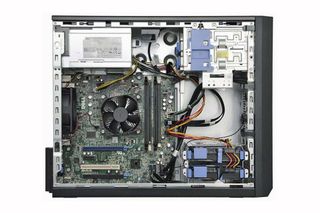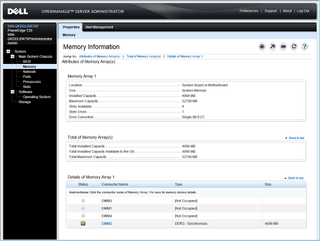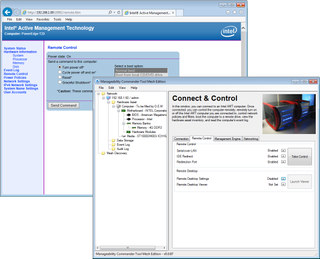IT Pro Verdict
The PowerEdge T20 is powerful and has plenty of storage potential making it suitable for SMBs and SOHOs wanting an affordable, purpose built server.
Pros
- +
Good value; Quiet; Upgradeable storage; Low power usage
Cons
- -
Basic server management
Dell's latest PowerEdge T20 aims to offer an alternative for small businesses relying on a simple NAS box to provide shared storage to their users. Designed as a purpose built server, the T20 targets a range of home offices, SOHOs and remote offices.
This compact desktop system looks good value and we found it to be quiet. Competition comes from products such as the ProLiant MicroServer Gen8 and in this review we see if Dell has the edge over HP.
Unlike the beefier PowerEdge T110 II, the latest T20 is offered in two fixed processor configurations. For 219, the entry model has a 3GHz Pentium G3220 CPU, 4GB of UDIMM memory and no hard disks.
Adding a 500GB hard disk to the entry model takes the asking price up to 264. Our review was top of the range with a quad-core 3.2GHz E3-1225 V3 Xeon, 4GB of UDIMM memory and a 1TB SATA hard disk. It was priced at 389.

Interior design provides good access and you can add more hard disks in the upper bays
Upgrades and customer kits
Bear in mind all these prices only include the most basic parts-only one year warranty. If you don't want to indulge in RTB, carry-in or collect and return games you can upgrade at the time of purchase with, for example, a three-year ProSupport on-site NBD agreement only adding an extra 84 ex VAT.
Apart from the CPU, you can upgrade all three servers by adding various customer kits with Dell offering 4GB and 8GB memory kits and a choice of extra SATA LFF and SFF hard disks or SSDs. The optional slim-line DVD drive costs a further 35 and doesn't include a SATA cable.
The T20 comes as standard with two internal drive cages each supporting a pair of LFF hard disks. The lower cage is easily accessed as the drives slide out towards you and the upper cage can be released and removed through the front panel.
All power and SATA cables are ready and waiting for extra drives and the cages have plastic carriers and mounting screws installed as well. If you don't need an optical drive you can use its tray on the upper drive cage to fit two SFF SATA drives.
You can fit a maximum of four LFF and two SFF drives but the motherboard only has four SATA ports so you'll need an extra controller card plus SATA and power extension cables for two of them. The two lower SATA ports are the 6Gbps variety and the upper pair runs at 3Gbps.
The C226 chipset includes Intel Rapid Storage Controller which supports mirrors and stripes only.

Dell's OpenManage Server Administrator provides some useful server monitoring tools
Features and noise levels
The server sprouts plenty of USB ports with a total of eight USB 2 and four USB 3. These are separated into four groups and a useful security feature is the ability to enable or disable any or all groups in BIOS.
General build quality is good and the removable steel side panel can be padlocked shut. The hole is large enough to slip a security cable through it so the server can be tethered to a desk.
Cooling is handled by an active heatsink on the CPU plus a 9cms diameter chassis fan behind it and noise levels are extremely low making the T20 a fine choice for small offices. Power usage is minimal as well and we measured the review server sipping 30W in idle and peaking at only 42W under heavy load.
The T20 has a greater storage potential and a more powerful CPU than HP's MicroServer Gen8 but it's beaten soundly for remote management. The MicroServer has HP's standard setting iLO4 embedded controller and its Intelligent Provisioning tool for swift OS installation.

RAID arrays can be managed using Intel's Rapid Storage Technology Windows utility
Intel AMT
Dell's preferred remote management solution for the T20 is Intel's AMT (active management technology) which is only available on the vPro Xeon model. You'll need to configure the Intel Management Engine BIOS Extension (MEBx) which is accessed on the T20 by selecting F12 from the one-time boot menu.
AMT provides basic browser access to the server where you can monitor critical hardware and directly control power. If you want more you'll need to source a compatible app we use Intel's Manageability Developer Tool Kit and its Commander Tool.
Dell's free OpenManage Essentials is far too heavy for this server. Its list of installation prerequisites is excessive and we found the current v1.2 doesn't support installation on Windows Server 2012 R2.
If you want a simpler means of monitoring the T20 then try Dell's free OpenManage Server Administrator. It's easy to install, works with Server 2012 R2 and provides reasonable levels of system information plus a basic fault alerting system.

Not the easiest to configure, but Intel's AMT lets you remotely manage the T20
Overall
HP's ProLiant MicroServer Gen8 might not have the processing power over the PowerEdge T20 but it does have the better remote management tools. This aside, the T20 is worth considering as a first server for a small business as it's good value, can be upgraded with a range of customer kits and is quiet.
Verdict
The PowerEdge T20 is powerful and has plenty of storage potential making it suitable for SMBs and SOHOs wanting an affordable, purpose built server.
Chassis: Desktop
CPU: 3.2GHz E3-1225 V3 Xeon
Chipset: Intel C226
Memory: 4GB 1600MHz DDR3 UDIMM (max 32GB)
Storage: 1TB Dell 7.2K SATA cold-swap hard disk (max 6)
RAID: Embedded Intel Rapid Storage Controller
Array support: RAID0, 1
Expansion: 3 x PCI-Express; 1 x PCI
Network: Gigabit
Other ports: 8 x USB 2; 4 x USB 3
Power: 290W fixed PSU
Warranty: 1yr parts only warranty
Dave is an IT consultant and freelance journalist specialising in hands-on reviews of computer networking products covering all market sectors from small businesses to enterprises. Founder of Binary Testing Ltd – the UK’s premier independent network testing laboratory - Dave has over 45 years of experience in the IT industry.
Dave has produced many thousands of in-depth business networking product reviews from his lab which have been reproduced globally. Writing for ITPro and its sister title, PC Pro, he covers all areas of business IT infrastructure, including servers, storage, network security, data protection, cloud, infrastructure and services.



